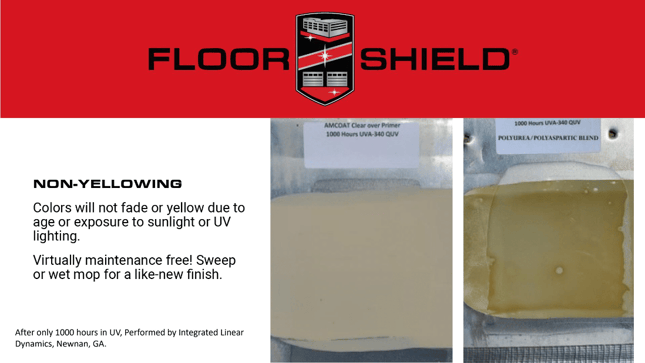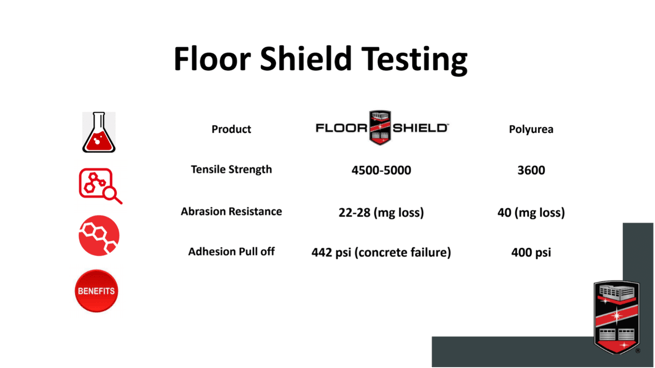Comparing the Costs: Floor Shield vs. Traditional Floor Coatings
December 19th, 2023 | 4 min. read

Selecting the right flooring solution for your space is a critical decision, balancing factors like cost, durability, and maintenance. In recent years, polyaspartic coatings have emerged as a promising alternative to traditional floor coatings, such as epoxies and polyurea. This begs the question, how are polyaspartic coatings different? And are they worth the steeper price tag?
Here at Floor Shield, we use a 100% polyaspartic coating, but we want to answer these questions honestly. While we recommend our polyaspartic product in most cases, we also sell a whole line of epoxies. So, let’s dive into the advantages and drawbacks of all 3 types of concrete coatings.
How Much Does It Cost to Coat My Floor?
Floor shield offers a balance between cost and quality. The price for our product is typically between $6.50 - $9 per square foot. This pricing is competitive with traditional epoxy coatings, which can range anywhere from $3 - $10 per square foot depending on the quality. Polyureas, which are known to be superior to epoxies, start at $6 and go all the way to $10 per square foot. While a polyaspartic coating may have a higher low-end price point than its competitors, its durability, UV stability, and longevity often translate into long-term cost savings.
- Due to limited competition in their areas, some businesses inflate lower-grade epoxy coatings to as much as $10 per square foot.
- Polyaspartic coatings offer a competitive pricing structure, ensuring you receive value for your investment.
How Long Does It Take Polyaspartic Coatings to Dry?
Polyaspartic coatings are prized for their quick drying times, making them ideal for projects that require a fast turnaround. While epoxy coatings may take up to two days to completely dry, Floor Shield can dry in as little as 5 to 6 hours during standard installations. This is great news for businesses, as it means the time their establishment stays closed for renovations is minimized.
Polyaspartic coatings, like Floor Shield, rely on aliphatic chemistry. This means that they cure more quickly in hot or humid conditions. While this can be advantageous, it also requires installers to take extra precautions to ensure the coating dries at the desired pace. This complicates the coating process and makes proper training paramount.
AmCoat provides a comprehensive training program to all Floor Shield dealers, equipping installers with the knowledge to handle varying climates effectively.
A quick drying time means the installation must be completed faster, which increases labor costs, as it takes multiple installers to complete a job to account for this. Since epoxy floor coatings take up to 2 days to dry, many jobs only require one installer, which decreases the job’s total cost.
Polyaspartic Coatings are UV Stable
Floor Shield is formulated as a 100% polyaspartic concrete coating. Unlike epoxy and polyurea-based formulas, polyaspartic coatings offer UV protection. This UV resistance ensures that your floor doesn’t fade and yellow, maintaining its color vibrancy when exposed to sunlight. This makes it a suitable choice for outdoor applications.
Even mostly indoor environments, like garages, can benefit greatly from this solar resistance. 95% of garages receive some form of direct sunlight in the first 12 - 18 inches. This underscores the significance of having a UV-stable product to ensure consistent color and durability throughout the entire floor surface. To save on cost, using polyaspartic coatings on sections more prone to sun exposure combined with non-UV-stable coatings on the rest of your floor can result in color disparities and potential product mixing issues, which is why we recommend going with a 100% polyaspartic floor.
Below is a comparison between our 100% polyaspartic clear coat (left) and a polyurea/polyaspartic blend (right).

How Strong are Polyaspartic Coatings?
Polyaspartic coatings exhibit a balance between flexibility and rigidity. While their rigid structure contributes to durability, they are also flexible enough to accommodate minor substrate movement.
However, in settings where multiple coatings must be applied for a thick floor, like where heavy machinery and vehicles drive over regularly, epoxies are the only option. Polyaspartics don’t adhere properly when coated too thick, whereas epoxies pose no issues after applying multiple layers.
When tested against polyurea coatings, which are known to be more durable than traditional epoxies, Floor Shield proved to be the clear winner in strength.

Exceptional Gloss Retention
Floor Shield boasts double the gloss retention compared to typical epoxy-based formulas. This means that your floor will maintain its shine and aesthetic appeal for much longer.
Do Polyaspartic Coatings Have VOC’s
Polyaspartic coatings, specifically Floor Shield, are renowned for their lack of Volatile Organic Compounds (VOCs). This is different for epoxies, which are high in these harmful chemicals. The absence of harmful VOCs contributes to a breathable indoor environment. This feature ensures that the application of Floor Shield is safe for both installers and occupants.
Do cracks matter when using Polyaspartic Coatings?
One of the notable advantages of polyaspartic coatings is their ability to coat over hairline cracks, leaving behind no trace of previous damage. This restorative feature significantly improves the look and condition of your floor, extending its lifespan and reducing the need for additional repairs.
Surface Preparation
One key factor contributing to the effectiveness of polyaspartic coatings is the meticulous surface preparation process. Unlike some epoxy coatings that rely on muriatic acid etching, polyaspartic coatings are typically applied to surfaces that have been ground down to an even level. This enhances adhesion and ensures a longer-lasting finish. As a result, many epoxy kits may have inferior warranties.
How does Floor Shield Account for Moisture?
Polyaspartic floor coatings don’t adhere well to concrete with high moisture content, but epoxies do. To circumvent this, in environments where moisture in the concrete is a concern, installers will use an initial epoxy moisture vapor-barrier coating. They will then finish with a topcoat of Floor shield. This added layer of protection can extend the life of your flooring, particularly in industrial settings where moisture is prevalent.
Ideal for Basements
Polyaspartic coatings like Floor Shield are particularly well-suited for basement applications. They provide protection against:
- Water damage
- Mildew
- Mold
This is a must for people who want to transform their basement into a lounge room or other livable space.
Floor Shield’s 15-year Warranty
Floor Shield offers a 15-year non-prorated warranty, providing peace of mind for long-term performance. In contrast, other products may offer lifetime warranties, but they are often prorated, meaning that coverage diminishes over time with the age of the product.
A Cost-Effective Choice
Floor Shield offers a compelling combination of durability, cost-effectiveness, and unique attributes that make it a strong contender in the flooring market. While the upfront cost may be slightly higher than some traditional options, these attributes make it more than worth the investment:
- Water resistance
- Rapid dry time
- Durability
- UV stability
- No VOCs
Whether you're looking to enhance the aesthetics of your garage, basement, or business, Floor Shield presents a durable and versatile solution that stands up to the demands of various environments, making it a great option for long-term value.
Conclusion: It’s Up to You
Ultimately, the choice between polyaspartic and more traditional coatings are up to your specific needs, budget, and preferences. We recommend working with experienced professionals who are well-versed in the application of concrete coatings to ensure the success and longevity of your flooring project.
However, if you are on a tighter budget and can't afford an installation crew, we recommend going with a more DIY-friendly option like concrete painting or staining.
If you’re interested in Floor Shield’s benefits and would like to get a free, no-obligation quote, scroll down.
